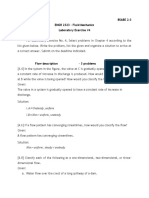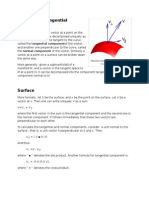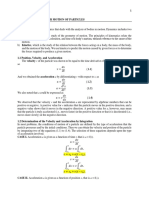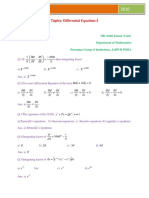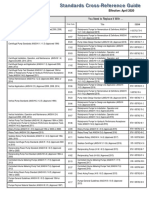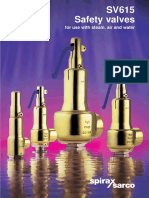NU - Lecture 4 FLUID FLOW MEASUREMENT PDF
Uploaded by
Harold Roinan BeñabonNU - Lecture 4 FLUID FLOW MEASUREMENT PDF
Uploaded by
Harold Roinan BeñabonHYDRAULICS
Lecture 4. Fluid Flow Measurements
Learning Objectives.
After this lesson, students should be able to
1. Understand the application of Bernoulli’s Energy 𝟐𝒈𝑯
𝒗𝟐 =
Equation in flow measurements. √ 𝒅 𝟒
𝟏 − ( 𝟐)
2. Familiarize with the differerent flow measuring 𝒅𝟏
devices and discuss how these are used in Where:
determining fluid properties. H= energy heads producing flow
3. Derive the fomulas for each flow measuring devices ∆𝑃
𝐻 = ∆𝑧 +
for the calculation of other unkown fluid properties. 𝛾
4. Use the derived equations in solving flow ∆𝑧 = 𝑧1 − 𝑧2
measurement related problems. 𝑃 𝑃1 𝑃2
∆ = −
𝛾 𝛾 𝛾
Required Knowledge in:
1. Continuity Equation 3. NOZZLE
2. Bernoulli’s Energy Equation
It is a device installed or connected at the end of the
3. Principle of Manometry
pipe or hose for the purpose of increasing the velocity
4. Projectile Motion
of the issuing jet.
1. PITOT TUBE
It is a device used for measuring the velocity of flow at
any point in a pipe or a channel. It is based on the principle that if
the velocity of flow at a point becomes zero, the pressure there
is increased due to the conversion of the kinetic energy into
pressure energy. In its simplest form, the pitot-tube consists of a
glass bent at right angles as shown:
𝒗𝟏 = √𝟐𝒈(𝒉𝟐 − 𝒉𝟏 )
But ∆𝒉 = 𝒉𝟐 − 𝒉𝟏 4. ORIFICE METER
Thus, 𝒗𝟏 = √𝟐𝒈∆𝒉 It is a small opening of any cross section (such as
circular, triangular, rectangular etc.) on the side or at the bottom
of a tank, through which a fluid is flowing.
2. VENTURIMETER
It is a device used for measuring the rate of a flow of
a fluid flowing through a pipe. It consists of converging
part, throat and diverging pipe.
𝟐𝒈𝑯
𝒗𝒐 =
√ 𝒅𝒐 𝟒
𝟏−( )
𝒅𝒑
Hydraulics Leselle C. Quitaneg
3. In a test to determine the discharge coefficient of a 2”
HYDRAULIC COEFFICIENTS by ½” venturimeter, the total weight of water passing
through the meter in 5 mins was 768 lbs. A mercury-
water differential gage connected to the inlet and
Coefficient of Discharge, Cd
throat showed an average mercury difference of 1.18
Also called meter coefficient. ft. Determine the meter coefficient.
𝑸𝒂𝒄𝒕𝒖𝒂𝒍
𝑪𝒅 = = 𝑪𝒄 𝑪𝒗
𝑸𝒕𝒉𝒆𝒐𝒓𝒆𝒕𝒊𝒄𝒂𝒍
Coefficient of velocity, Cv
𝒗𝒂𝒄𝒕𝒖𝒂𝒍 𝒗𝒋𝒆𝒕
𝑪𝒗 = =
𝒗𝒕𝒉𝒆𝒐𝒓𝒆𝒕𝒊𝒄𝒂𝒍 𝒗𝒐
Coefficient of contraction, Cc
𝟐 4. A 2” circular orifice (not standard) at the end of the 3-
𝑨𝒂𝒄𝒕𝒖𝒂𝒍 𝑨𝒋𝒆𝒕 𝒅𝒋𝒆𝒕 in diameter pipe shown in the figure discharges into
𝑪𝒄 = = =( ) the atmosphere a measured flow of 0.6 cfs of water
𝑨𝒕𝒉𝒆𝒐𝒓𝒆𝒕𝒊𝒄𝒂𝒍 𝑨𝒐 𝒅𝒐
when the pressure in the pipe is 10 psi. The jet velocity
is determined by a pitot tube to be 39.2 fps. Find the
device coefficients.
EXAMPLES.
1. A 2.5” fire hose discharges water through a nozzle
having a jet diameter of 1”. The head loss in the nozzle
is 4% of the velocity head of the jet. If the gage
pressure at the base of the nozzle is 60 psi, find
a. the flow in gpm.
b. Maximum horizontal range to which the stream
can be thrown, I the fire hose is placed 135 ft
from the ground.
2. A mercury-kerosene manometer is connected to a
pitot-tube as shown. The deflection on the
manometer is 7 in. Assume specific gravity of
kerosene is 0.81.
a. What is the difference in pressures between
point 1 and point 2?
b. What is the kerosene velocity in the pipe?
c. What is the flow rate in the pipe if its diameter
is 6”?
Hydraulics Leselle C. Quitaneg
You might also like
- Checklist For Testing & Commissioning of Sprinkler System90% (10)Checklist For Testing & Commissioning of Sprinkler System2 pages
- Activity 2 Applications of System of Linear Equations-1No ratings yetActivity 2 Applications of System of Linear Equations-16 pages
- Principles of Hydrostatics (CE 023 Fluid Mechanics)No ratings yetPrinciples of Hydrostatics (CE 023 Fluid Mechanics)19 pages
- Basic Properties of Fluid Flow (EU - 2)No ratings yetBasic Properties of Fluid Flow (EU - 2)15 pages
- Total Hydrostatic Forces On Plane SurfaceNo ratings yetTotal Hydrostatic Forces On Plane Surface7 pages
- Applications of First Order Differential EquationsNo ratings yetApplications of First Order Differential Equations9 pages
- Ce122:Hydrology: Kristine R. Cervancia, Rce, MsceNo ratings yetCe122:Hydrology: Kristine R. Cervancia, Rce, Msce19 pages
- PCEA 006 - Module 4 - Reversed Effective ForceNo ratings yetPCEA 006 - Module 4 - Reversed Effective Force10 pages
- With Solutions MATH22 - Engineering Data Analysis Module 3No ratings yetWith Solutions MATH22 - Engineering Data Analysis Module 329 pages
- Fluid Mechanics: Statical Stability of Submerged Bodies ObjectivesNo ratings yetFluid Mechanics: Statical Stability of Submerged Bodies Objectives6 pages
- Payabyab, WI - Basic EE and ECE - PSET 1No ratings yetPayabyab, WI - Basic EE and ECE - PSET 111 pages
- Set 7 Fluid Properties and Hydrostatic ForceNo ratings yetSet 7 Fluid Properties and Hydrostatic Force12 pages
- Chapter 5.4 Headloss Due To Friction (Classroom)No ratings yetChapter 5.4 Headloss Due To Friction (Classroom)26 pages
- Ce 215 Engineering Econ Module CompilationNo ratings yetCe 215 Engineering Econ Module Compilation129 pages
- 1.2 Fundamentals of Fluid Flow - Bernoulli's Energy Theorem100% (1)1.2 Fundamentals of Fluid Flow - Bernoulli's Energy Theorem12 pages
- Activity 3: DC Power Measurements 3.1 Power in A Series Resistive Circuit 3.1.1 Program Outcomes (Pos) Addressed by The ActivityNo ratings yetActivity 3: DC Power Measurements 3.1 Power in A Series Resistive Circuit 3.1.1 Program Outcomes (Pos) Addressed by The Activity24 pages
- Engg Economy 061911 Rev (Compatibility Mode)No ratings yetEngg Economy 061911 Rev (Compatibility Mode)28 pages
- Experiment No. 2 Familiarization of Hydraulic Bench ApparatusNo ratings yetExperiment No. 2 Familiarization of Hydraulic Bench Apparatus5 pages
- Fluid Mechanics Hydraulics by Gillesania Chapter 2No ratings yetFluid Mechanics Hydraulics by Gillesania Chapter 223 pages
- Fluid Mechanics With Problems and SolutionsNo ratings yetFluid Mechanics With Problems and Solutions67 pages
- Lesson 3.1 Total Hydrostatic Forces and PressuresNo ratings yetLesson 3.1 Total Hydrostatic Forces and Pressures19 pages
- Rekayasa - BQ Pusri STG & Coal Boiler ProjectNo ratings yetRekayasa - BQ Pusri STG & Coal Boiler Project18 pages
- Common Hydraulic Problems - Symptoms and Causes - Hydraproducts - Hydraulic Systems - Hydraulic Power Packs - BlogNo ratings yetCommon Hydraulic Problems - Symptoms and Causes - Hydraproducts - Hydraulic Systems - Hydraulic Power Packs - Blog3 pages
- If You Have You Need To Replace It With : Title Title Isbn#No ratings yetIf You Have You Need To Replace It With : Title Title Isbn#2 pages
- Iron Removal-Softener & Drinking Water Treatment Plant - DrawingNo ratings yetIron Removal-Softener & Drinking Water Treatment Plant - Drawing1 page
- ONGC - Mehsana P&ID For Chemical Dosing Skid-1100% (1)ONGC - Mehsana P&ID For Chemical Dosing Skid-11 page
- Quick Revision Course of FM For Uppsc - Ae (In Unacademy Free Special Classes) Byjsgill Everyday 8:00 AM To 9:00 AM Starting From 3 October OnwardsNo ratings yetQuick Revision Course of FM For Uppsc - Ae (In Unacademy Free Special Classes) Byjsgill Everyday 8:00 AM To 9:00 AM Starting From 3 October Onwards2 pages
- SOUR WATER STRIPPER & DISPOSAL SYSTEM AT BERRI GAS PLANT PROGRESS MEASUREMENT SYSTEM REPORT Project ID BI-10-01628No ratings yetSOUR WATER STRIPPER & DISPOSAL SYSTEM AT BERRI GAS PLANT PROGRESS MEASUREMENT SYSTEM REPORT Project ID BI-10-016282 pages



